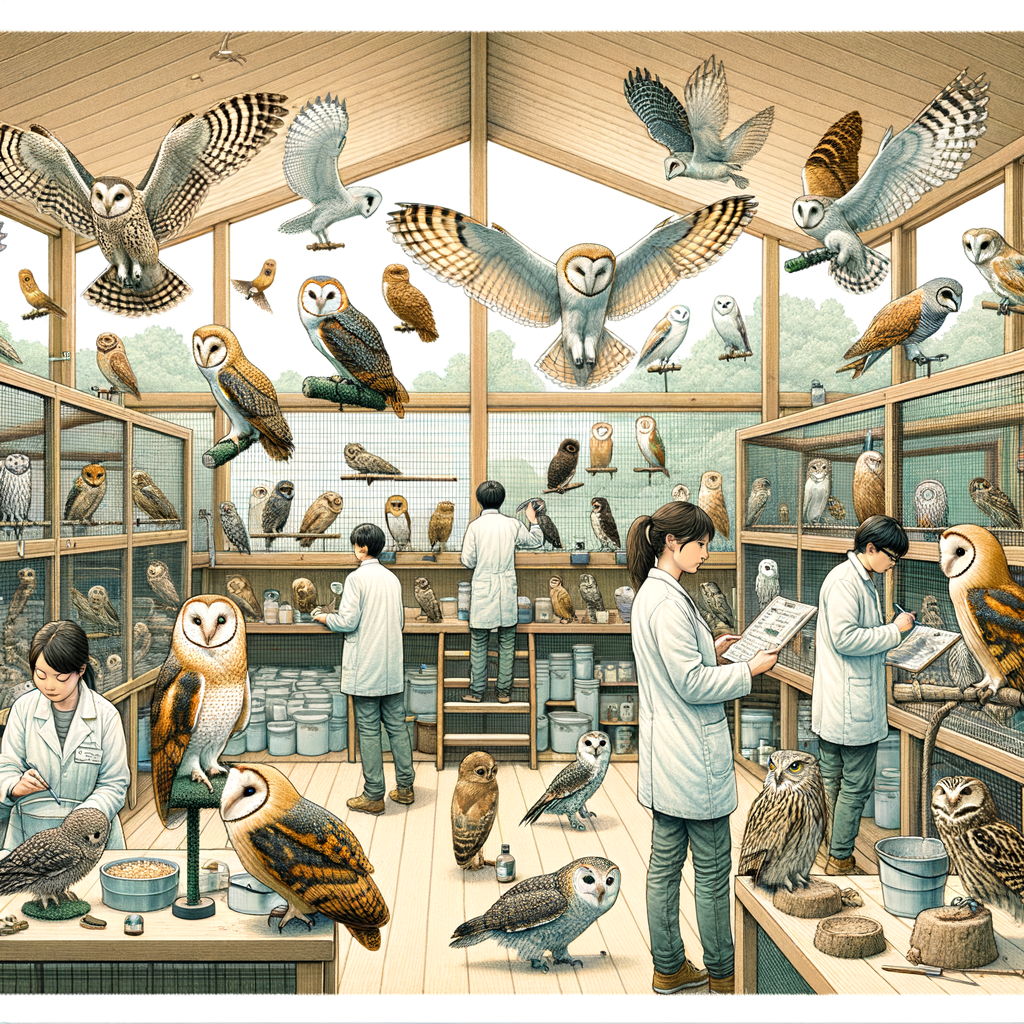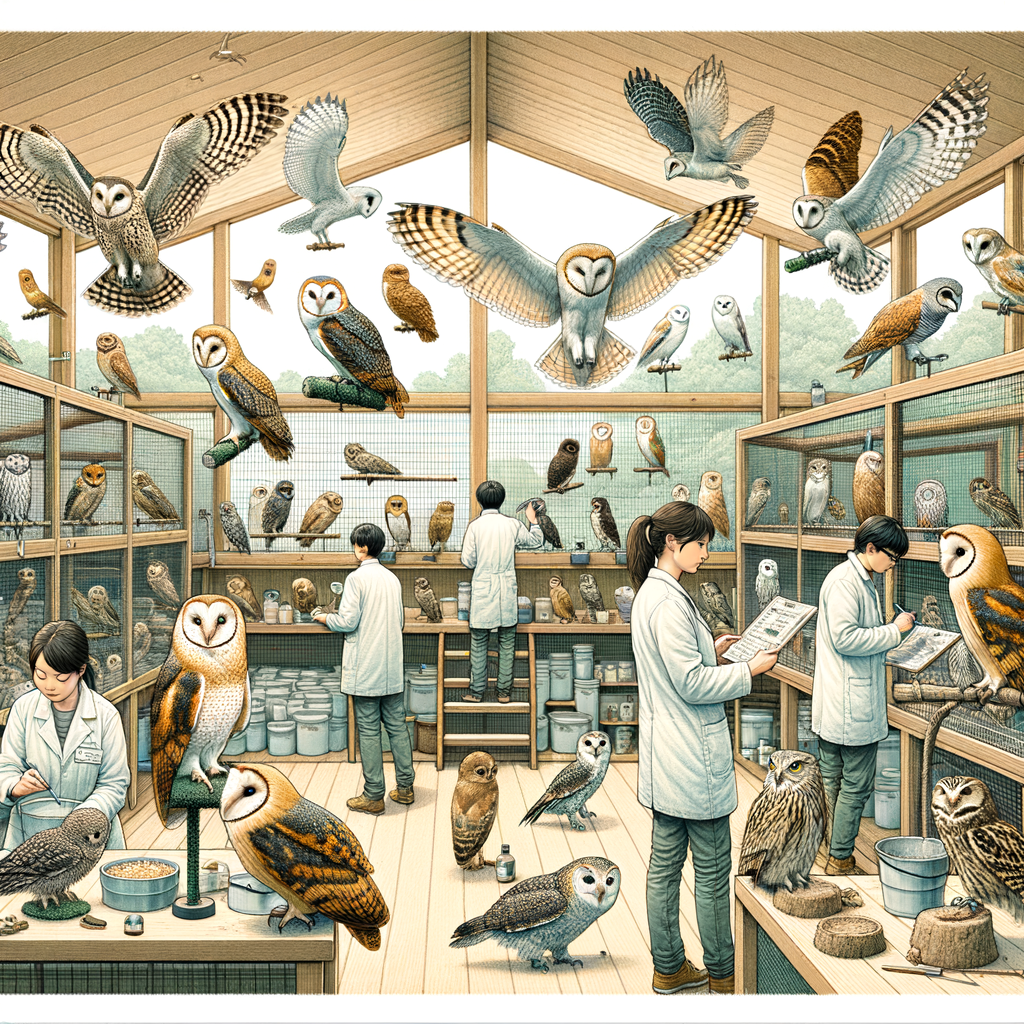
Introduction to Owls in Captivity
- The concept of captive owls: Captive owls are those that live in controlled environments like zoos, wildlife sanctuaries, or rehabilitation centers. These owls are not free to roam in the wild. Instead, they are cared for by humans. This can happen for many reasons, such as injury, illness, or conservation efforts.
- Importance of studying owl behavior in captivity: Observing owls in captivity helps scientists learn more about their habits and needs. This knowledge is crucial for ensuring their well-being. For example, understanding their diet, nesting habits, and social behaviors can help improve their care. It also aids in conservation efforts, helping to protect owl species in the wild.
Captive Owl Behavior
Common Behaviors of Owls in Captivity
- Observing owl habits in captivity: Often show different behaviors compared to their wild counterparts. They may perch in specific spots, preen their feathers more frequently, or interact with their environment in unique ways. Observing these habits helps caretakers understand their needs better.
- Significance of owl behavior studies: It helps in improving their living conditions and ensuring they are healthy and happy. For example, understanding why an owl might be more active at night can help in adjusting feeding times. These studies also provide insights that can be applied to conservation efforts in the wild.
| Behavior | Significance |
|---|---|
| Perching | Indicates comfort and territory marking |
| Preening | Shows grooming habits and health status |
| Vocalizing | Communication and expressing needs |
Behaviors of Different Owl Species
- Comparing behaviors of different owl species in captivityOwls are fascinating creatures, and each species has its own unique behaviors. In captivity, these behaviors can be quite different from those in the wild. For example, the Barn Owl is known for its silent flight and hunting skills. In captivity, they often show these skills during feeding times.
On the other hand, the Great Horned Owl is more aggressive and territorial. They may show dominance behaviors even in captivity. Understanding these differences helps in providing better care and enrichment for each species.
- The factors influencing these behaviorsOne major factor is the environment. Owls need space to fly and hunt, even in captivity. If they don’t have enough space, they may become stressed or show unusual behaviors.
Another factor is diet. Owls need a diet that mimics what they eat in the wild. For example, a diet rich in small mammals and birds is essential for their health and well-being. Providing the right diet can help maintain their natural behaviors.
Finally, social interactions play a role. Some owl species are solitary, while others may enjoy the company of another owl. Understanding these social needs is crucial for their mental health.
| Owl Species | Unique Behavior | Influencing Factors |
|---|---|---|
| Barn Owl | Silent flight, hunting skills | Space, diet |
| Great Horned Owl | Aggressive, territorial | Space, social interactions |
Understanding these unique behaviors and the factors that influence them is key to providing the best care for owls in captivity. By doing so, we can ensure their well-being and help them thrive even outside their natural habitats.
Owl Care in Captivity
Essentials of Owl Health in Captivity
- Importance of regular health checks for captive owls: Regular health checks are crucial for owls in captivity. These checks help in early detection of illnesses and ensure the owl’s well-being. A vet can check for signs of stress, malnutrition, and other health issues. Regular health checks can prevent serious problems and help owls live longer, healthier lives.
- Common health issues faced by owls in captivity: Some common problems include respiratory infections, feather damage, and obesity. Respiratory infections can be caused by poor air quality or stress. Feather damage often results from improper housing or diet. Obesity can occur if the owl is overfed or lacks exercise. Addressing these issues promptly is essential for maintaining the owl’s health.
| Health Issue | Cause | Prevention |
|---|---|---|
| Respiratory Infections | Poor air quality, stress | Ensure clean environment, reduce stress |
| Feather Damage | Improper housing, diet | Provide proper housing, balanced diet |
| Obesity | Overfeeding, lack of exercise | Monitor diet, encourage exercise |
Captive Owl Diet
-
The Dietary Needs of Owls in Captivity
Owls in captivity need a balanced diet to stay healthy. They usually eat small mammals like mice and rats. Sometimes, they also eat birds, insects, and fish. It’s important to give them food that is similar to what they eat in the wild.
Here is a table showing the common foods for captive owls:
Food Type Examples Small Mammals Mice, Rats Birds Chicks, Quail Insects Crickets, Mealworms Fish Small Fish Feeding owls the right food helps them stay strong and active. It also helps them avoid health problems.
-
Impact of Diet on Owl Behavior
If they get the right food, they are more likely to be happy and calm. If they don’t get enough food or the wrong kind of food, they might become stressed or sick.
For example, a study showed that owls fed a diet similar to their wild diet were more active and showed natural behaviors. On the other hand, owls that did not get the right food were less active and seemed unhappy.
Therefore, it’s very important to feed captive owls a diet that meets their needs. This helps them live a better life in captivity.
Owl Enrichment in Captivity
Importance of Enrichment for Captive Owls
It helps them stay healthy and happy. Without enrichment, owls can get bored and stressed. This can lead to health problems. Enrichment activities keep their minds and bodies active. It also helps them show natural behaviors.
Examples of Effective Enrichment Activities
There are many ways to enrich an owl’s life in captivity. Here are some examples:
- Perches: Different types of perches can be used. They can be made of wood or other materials. This helps owls exercise their feet and legs.
- Food Puzzles: Hiding food in puzzles makes owls work for their meals. This keeps their minds sharp.
- Toys: Owls enjoy playing with toys. They can be simple, like balls or ropes. Toys help keep owls entertained.
- Flight Space: Providing space for owls to fly is very important. It helps them stay fit and healthy.
- Natural Items: Adding branches, leaves, and other natural items to their enclosure can make it more interesting. It also helps owls feel more at home.
These activities can make a big difference in the lives of captive owls. They help keep the owls engaged and healthy.
Owl Breeding in Captivity
The Breeding Process
Breeding owls in captivity can be a complex process. It requires a deep understanding of their natural behaviors and needs. Let’s explore the challenges and some successful case studies.
-
Challenges of owl breeding in captivity:
- Environmental Needs: Owls need specific conditions to breed. This includes the right temperature, humidity, and light.
- Diet: Providing a diet that mimics their natural food is crucial. Owls need a balanced diet to stay healthy and reproduce.
- Space: Owls need enough space to feel comfortable. Small enclosures can stress them out, making breeding difficult.
-
Successful case studies of captive owl breeding:
- San Diego Zoo: The San Diego Zoo has successfully bred several owl species, including the Barn Owl. They use large, naturalistic enclosures to mimic the owls’ natural habitat.
- Smithsonian’s National Zoo: This zoo has had success with the Snowy Owl. They focus on providing a diet rich in nutrients and creating a stress-free environment.
| Zoo | Species | Key Success Factors |
|---|---|---|
| San Diego Zoo | Barn Owl | Large enclosures, natural habitat |
| Smithsonian’s National Zoo | Snowy Owl | Balanced diet, stress-free environment |
Role of Breeding in Owl Conservation
-
Importance of Captive Breeding in Owl Conservation
It helps to protect endangered species. By breeding owls in captivity, we can increase their numbers and ensure they do not go extinct.
For example, the Spotted Owl is a species that has benefited from captive breeding programs. These programs have helped to boost their population and protect them from threats in the wild.
-
Impact of Captive Breeding on Owl Populations
It allows scientists to study owls closely and learn more about their needs. This knowledge helps in creating better conservation strategies.
According to a study, captive breeding programs have increased the population of certain owl species by up to 30%. This is a significant improvement and shows the effectiveness of these programs.
Here is a table showing the impact of captive breeding on different owl species:
Owl Species Population Increase (%) Spotted Owl 25% Burrowing Owl 30% Snowy Owl 20%
Conclusion: The Future of Owls in Captivity
Understanding their behavior and providing proper care are crucial for their well-being. Let’s summarize the key points and explore what lies ahead for owl conservation in captivity.
-
Key takeaways on owl behavior and care in captivity:
- Owls need a habitat that mimics their natural environment as closely as possible.
- Proper diet and regular health check-ups are essential for their physical well-being.
- Enrichment activities, such as toys and puzzles, help keep owls mentally stimulated.
- Understanding individual owl behavior helps in providing personalized care.
-
Future prospects for owl conservation in captivity:
- Advancements in veterinary care will improve the health and longevity of captive owls.
- Increased awareness and education can lead to better conservation efforts.
- Collaboration between zoos, wildlife sanctuaries, and researchers will enhance breeding programs.
- Technological innovations, like virtual reality, could provide new ways to enrich the lives of captive owls.
The future of owls in captivity looks promising with ongoing research and improved care practices. By continuing to learn and adapt, we can ensure these majestic birds thrive in captivity while also contributing to their conservation in the wild.






